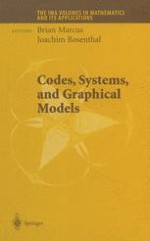2001 | OriginalPaper | Buchkapitel
Properties of the Tailbiting BCJR Decoder
verfasst von : John B. Anderson, Kemal E. Tepe
Erschienen in: Codes, Systems, and Graphical Models
Verlag: Springer New York
Enthalten in: Professional Book Archive
Aktivieren Sie unsere intelligente Suche, um passende Fachinhalte oder Patente zu finden.
Wählen Sie Textabschnitte aus um mit Künstlicher Intelligenz passenden Patente zu finden. powered by
Markieren Sie Textabschnitte, um KI-gestützt weitere passende Inhalte zu finden. powered by
The tailbiting BCJR algorithm extends the maximum a posteriori (MAP) decoder of Bahl et al. to the case of tailbiting trellis codes. The algorithm consists of forward and backward recursions that start from the left and right principal eigenvectors of the product of the trellis gamma matrices. The result is a slightly sub-optimal symbol-by-symbol MAP decoder that performs much less computation than the true MAP decoder. The decoder has both iterative and non-iterative realizations. We formally justify the algorithm and develop its properties. Storage of the entire recursion outcome is not required and we relate the needed length to the encoder memory and the encoder decision depth parameter. By tests of actual decoders, the bit error rate of the algorithm is compared to that of true MAP, maximum likelihood, and circular Viterbi decoders. For a given encoder, the BER of these decoders depends on the ratio of the tailbiting circle size to the encoder memory. We argue that there exists a certain practical optimum ratio of circle size to memory, and at this ratio the BER of the tailbiting BCJR decoder is essentially that of the true MAP decoder.
